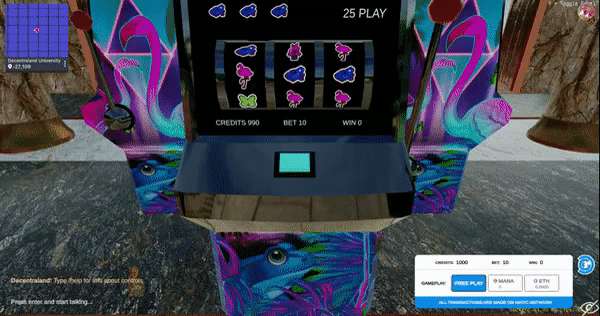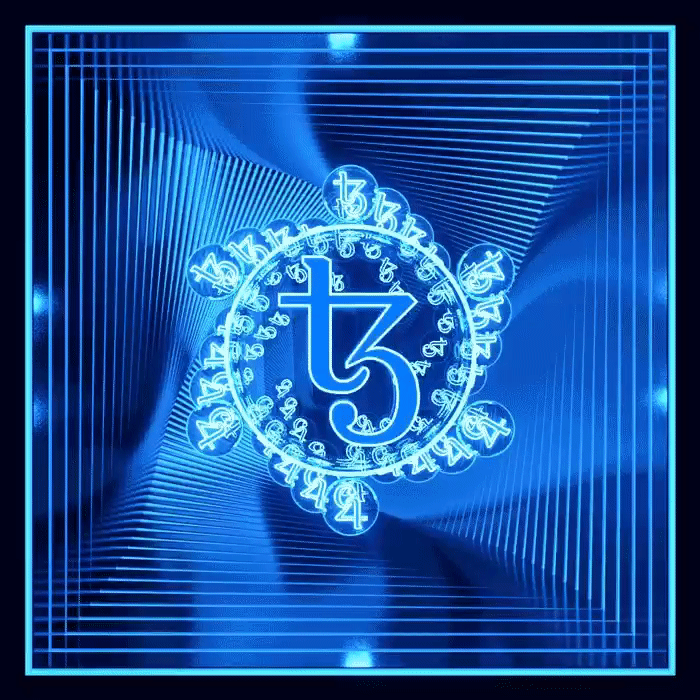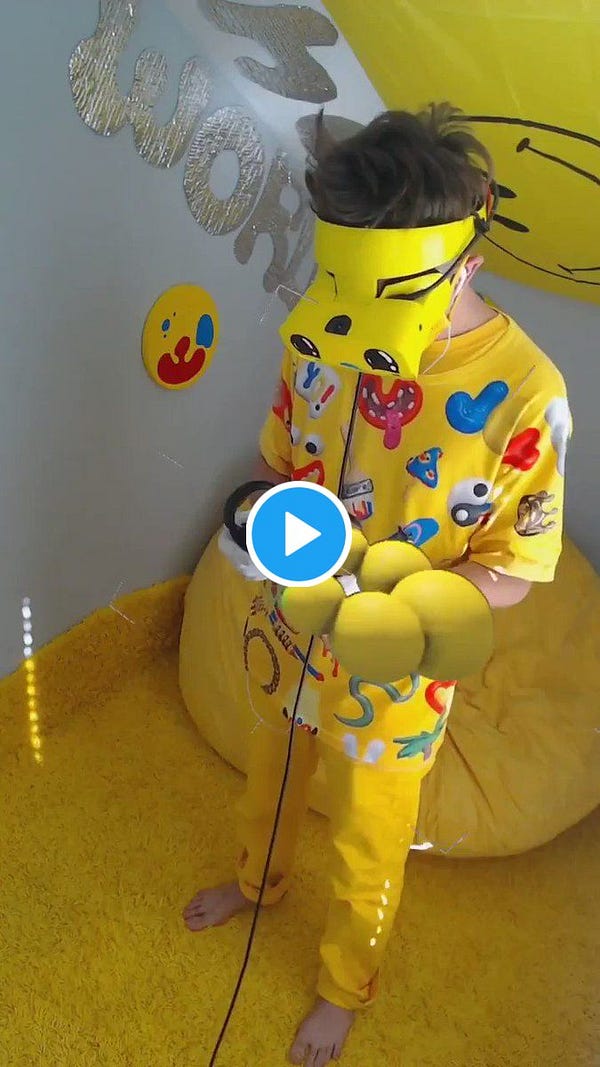🏆📸🔨Exploring "Proof-of-Work" Within The Non-Fungible Token Space
My sponsor for today’s blog is myself. Check out my amazing NFT/metaverse focused podcast, also called Zima Red. Here is a link to episode number 15 where I spoke with brothers Duncan and Griffin who are the founders of the NFT exchange, Nifty Gateway.
🚀🚀🚀Listen here! 🚀🚀🚀
They actually reminded me that I needed to finish this blog post and much of what we touched upon in our conversation is applicable to this idea of “Proof-of-Work.”
🏆📸🔨Exploring "Proof-of-Work" Within The Non-Fungible Token Space
Why do we love it when people put great effort into a creative process? Or in blockchain terms, why do we love learning about people's “proof-of-work” (PoW) for their creations? Even menial tasks can become incredible feats if someone has dedicated hours, days, or weeks to accomplish them. We enjoy it when someone invests immense effort into seemingly simple things, like setting up dominos, only for them to be knocked down.

Luxury goods are another example of PoW. People love finely crafted handmade bags, from obtaining a rare leather to an expert sewer to make detailed stitches with a specific technique. This concept even extends to the things we eat. This clip showcases a traditional Japanese salt farm and the arduous process they use to farm sea salt.
In a blind taste test do you think the majority of people could tell a difference between this salt and others? It doesn’t matter, because the process to achieve the Japanese sea salt is what sets it apart, not the taste.
When we learn about difficult and time-consuming processes, we assume that the pursuit leads to something special. The process of putting immense effort into a creative process causes intrigue, delight, and sometimes the desire to own the creation ourselves. Let’s consider this example from the art world.
Imagine I had two clones make the exact same piece of art. After they were finished, I asked each how long it took. Clone #1 said it took 10 minutes to create his art piece, but clone #2 said it took him 50 hours. Curious about the discrepancy, I asked each why it took them that length of time. Clone #1 took 10 minutes because he quickly painted the piece using some paint and canvas he had on hand. Clone #2 took 50 hours because he traveled to another country to obtain a rare dye that needed to be hand-crushed before painting. Then he went to the finest canvas weaver and learned how to weave the most incredible canvas. Finally, he used a certain upwards brushstroke throughout the entire piece that can only be accomplished at an extremely slow pace. Okay, you get it. When they finished, this was the end result.

Beautiful cat paintings (FYI I just pulled this random image off of Google).
The painting on the left was created by clone #1 in 10 minutes, while the painting on the right was created by clone #2 in 50 hours. If these pieces of art were the same price, then I would bet that the vast majority of people would prefer the one that took 50 hours if the PoW process was explained. Proof-of-work matters. The story and narrative around creation is very important to people. Work without a narrative is just work, but work with a story becomes a compelling journey.
Proof-of-Work Explained
The term proof-of-work in technology is actually about achieving consensus through a process that uses some form of effort, generally, compute power. The process should be hard to produce, but easy for observers to verify. Proof-of-work was first proposed in 1993 by Cynthia Dwork and Moni Naor as an anti-spam feature to deter denial-of-service attacks. Then in 1997, Adam Back created Hashcash, a proof-of-work system used to help eliminate email spam and denial-of-service attacks.
Hashcash was the proof-of-work system that Satoshi Nakamoto used for the bitcoin protocol. Bitcoin miners compete to solve the proof-of-work within bitcoin through computers that are constantly at work. The miners that solve the proof-of-work are rewarded with bitcoin. For more information, here is a short explainer video about proof-of-work consensus algorithms used in cryptocurrencies.
Other Consensus Methods
There are a multitude of other methods to achieve consensus within distributed systems, such as proof-of-stake, proof-of-burn, and more. Proof-of-stake works by randomly selecting certain participants known as validators. Validators “stake” cryptocurrency i.e. lock it into the network, and then validators are randomly chosen to produce and approve the next block.
In a proof-of-burn system, a miner or network participant shows proof that they have burned a certain amount of crypto tokens. The idea is that by burning some sort of asset the user is showing “proof-of-work” by being willing to destroy value in order to participate in the network. By burning coins in a verifiable manner, observers can determine that the participant is approved to create the next set of transactions. While all of these mechanisms help achieve consensus within a distributed network of computers, we can port these concepts to the physical world.
Proof-of-Work As Verifiable Status
Humans are hard-wired to seek status, and it can be effectively built through proof-of-work. I respect the work of the traditional Japanese salt farmer, the artist who toils over paintings, and the rare handmade handbag. When I learn that a creator took a shortcut, I feel cheated. We mentioned earlier that proof-of-work is hard to produce but easy to verify. Putting immense effort into an observable process is an efficient method to build status and earn respect within a system. If your proof-of-work is good (valid) then the other system participants will come to a consensus that your work is good, thus achieving status. Being the social animals that we are, humans usually care deeply about our status, especially within social groups. Now, let’s take a look at how people achieve status through social media PoW.
Social Media Proof-of-Work
Eugene Wei wrote an incredible blog about how social media uses various forms of proof-of-work. He explained that on Instagram the proof-of-work is users posting incredible photos. Users then “mine” the social currency of likes and comments. If I post a boring photo of an everyday object, it shows very weak proof-of-work. But posting an amazing photo of a beautiful sunset implies a strong proof-of-work because I moved into the best position, waited for the sunset, and then snapped a picture at exactly the right time. I will then be rewarded for my proof-of-work with the social currency of likes and comments.
The proof-of-work for the social app TikTok is slightly different. TikTok users have 15 seconds to lip-sync or dance to songs in order to mine their currency of likes and views. If a user copies a song or dance that everyone else has already seen, their reward will likely be minimal, but if they do something original then their proof-of-work increases, and their reward likely will too. For Twitch streamers, proof-of-work is achieved by playing video games for vast amounts of time and becoming exceptionally good. If users are good at a game, people will want to watch them play and reward the user with money donations.
Social media has created the most effective form for people to quickly achieve status. Now, let’s examine how PoW functions within video games.
Proof-of-Work Within Video Games
Proof-of-work exists within virtually all video games. There is almost always an objective to win or complete a game. With a simple game like Pong, the proof-of-work is spending hours building skills to beat the game. There is little status to be gained from playing Pong alone because it’s a single-player game. However, a player could achieve proof-of-work through creating YouTube videos documenting their Pong gameplay and their tireless effort.
Games like World of Warcraft have thousands of users playing simultaneously with the objective to level up a character, obtain stronger gear, and beat higher level bosses. You can instantly know if a player has put in massive amounts of work based on their level, gear, and weapons. In an open world game like Minecraft, the proof-of-work is rather broad. If you set out to build a massive castle, then the time spent gathering the necessary resources and building the structure is the proof-of-work. If you would like to defeat the Ender Dragon (the final boss) then you need to work towards mining the rarest resources, crafting the best weapons, and fighting the final boss. All games have proof-of-work.
Proof-of-Work Within NFT Games
Just like traditional video games, NFT games have varying proof-of-work models depending on the game’s culture. Some cultures encourage user-generated content, while some encourage other behavior. Here are a few NFT games and their PoW models.
Gods Unchained: Create a strong deck and beat opponents.
Decentraland: Build unique structures that attract people.
My Crypto Heroes: Build a strong team to fight opponents.
CryptoKitties: Breed cats to create rare collectible species.
Axie Infinity: Breed a strong team and win battles.
Cryptovoxels: Build unique structures that attract people.
Crypto Space Commanders: Build a powerful ship to mine more resources and control the galaxy.
The most obvious difference between proof-of-work for NFT games and regular video games is that NFT game users have skin in the game. In other words, the PoW for NFT games will often allow users to earn real money. For example, if I spent many hours building a beautiful structure in Cryptovoxels, I could likely sell that parcel of land for a higher price. In the game Axie Infinity, I could level up my Axie’s and sell them for a higher price. In these examples, my work leads to a direct value increase.
Proof-of-Work Within Open NFT-Based Worlds
It’s interesting to explore PoW models in open virtual worlds that have no direct objective, such as Decentraland, Cryptovoxels, Somnium Space, and The Sandbox. Their culture largely encourages proof-of-work to be user-generated content. In Decentraland, Cryptovoxels, and Somnium Space players build amazing structures, games, items, and in-world activities to showcase their work.
Cryptovoxel user Fayelure coded a virtual cat. This is a clear example of proof-of-work.
What is interesting about open worlds is that the proof-of-work process will likely evolve. As the platforms become more advanced, the PoW will likely become more technical and gravitate towards revenue generation. Generating revenue can be accomplished by things such as renting virtual land, selling digital goods, creating mini-games, or experiences that cost a small amount of crypto. The Flamingos Casino in Decentraland is a great example of this already happening. The casino is totally usable and players can earn real cryptocurrency.


Let’s now examine PoW in digital goods by examining the Cryptovoxels and Decentraland “wearables” category, which is essentially clothing and accessories for in-world avatars. People love to select personalized clothing in the physical world, and it turns out this is no different in the virtual world. If a user created a virtual clothing brand and earned revenue displaying and selling it from their land, it would be a huge indicator of PoW. But how could the virtual clothing designer garner even more PoW by showcasing their artistic process?
Proof-of-Work For NFT Artists
Some of the most intriguing proof-of-work methods are coming from crypto artists. The crypto artist Matt Kane tweeted the following to ponder new, fully-online proof-of-work methods.

In the digital realm, there is no paint, canvas, or traditional artistic tools, so crypto artists are showing their work process in other ways, such as blog posts, videos, and more. Crypto artist MightyMoose wrote a detailed blog post about his creative process here. Explaining the process creates a narrative around the artwork, and I would argue that this deeper understanding makes us like the work more. Proof-of-work does not have to just focus on the creative process: it can also be about the meaning behind a piece. A great example of this is a piece of art created by crypto artist Godfrey Meyer and commissioned by the prolific art collector WhaleShark.


The piece itself is quite beautiful and mesmerizing, but when WhaleShark further detailed the deeper meaning behind the piece it went from simply being cool to being incredible. Whaleshark explained how the elements, movement, color, and imagery all directly represent the actual technological process behind the “baking” (staking) of Tezos.

(Baking, proof-of-stake, and self-amendment are all real functions within the Tezos blockchain, making this piece have a deep meaning. Now that is proof-of-work.)
Nobody uses the creative process to showcase PoW better than the artist Joy. Joy creates his artwork live, so not only can people watch him during his artistic process, but they can interact with him via chat and can also purchase the NFT immediately after it has been minted. As assets become more digitized I expect to see even more creative ways in which artists show their PoW.


Lastly, I want to touch upon an interesting PoW model that can be used for any type of NFT, including art: staking tokens directly into NFTs. The first company to do this in a big way is Bullionix (admittingly there may have been others that I am not aware of). They allow users to stake DGX tokens directly onto NFTs, but the most interesting part is that DGX tokens are pegged to physical gold bullion. The creation of “gold-backed” NFTs opens an entirely new PoW sphere because the proof-of-work is very tangible. The proof-of-work is obtaining gold that has been literally mined from the ground, tokenizing the gold, then staking it to the NFT.
Unique PoW models like these are just the start of what I expect to be an explosion of various methods to showcase work in the digital realm.
Possible Proof-of-Work Models
(Here I will use NFT artists as the main example, but these models can be used by any NFT issuer.)
NFT creators can show proof-of-work by writing blogs, taking pictures, or filming videos of their creative process. They can even detail what type of software they use, such as photoshop, CAD, Adobe After Effects, etc. The content could be posted on social channels or directly on the NFT itself. Conlan, the founder and developer at Async Art, created a tool called Scribe that allows people to write messages on their tokens.
Another interesting potential proof-of-work model for artists is to implement a proof-of-burn structure to sell NFTs. The artist could create a system that says, “In order to purchase my newest NFT, you must send me one of my previous works, which I will then burn.” The artist could even say that you need to burn multiple pieces in order to have the option to purchase a new one. This would reduce the outstanding number of tokens from that artist, thus increasing the rarity of the existing works.
There is also a type of proof-of-stake model where potential NFT buyers must stake tokens to the artist for a specific amount of time in order to buy a new NFT. This idea was inspired by 2100.co, who built a sort of tokenized social graph using Twitter. With many artists creating their own ERC20 currencies, staking models will likely evolve to utilize them. Perhaps those who stake using an artist's native currency will be given special rights, like the right of first purchase.
We could also see interesting proof-of-work models in which artists require collectors to contribute compute power to something like Folding @ Home, which uses computational power to analyze how to best fight specific diseases.
Lastly, it would also be interesting if an artist created a Chrome extension that mines cryptocurrency in the browser, and once the collector has mined a specific amount of crypto for the artist the collector receives a piece of art.
Future Proof-of-Work
People love proof-of-work. When something is more laborious, documented, and understood it is innately more valuable. There is no doubt that we will continue to see innovative proof-of-work models for NFTs emerge in the near future. If you have any thoughts on future proof-of-work models, feel free to DM me on Twitter so we can geek out together!

If you liked this content please subscribe to my newsletter, Zima Red, and give me a follow on Twitter. Stay tuned for more articles on unique digital assets and all things virtual. 😎


